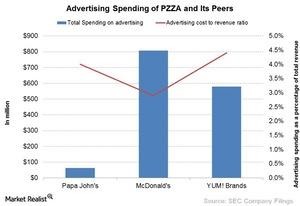Papa John’s Marketing and Promotional Strategies: What’s in the Oven?
In 2014, Papa John’s spent $63 million, or 4% of its total revenues, on advertising, whereas McDonald’s spent $808 million, or 2.9% of its total revenues.
Dec. 16 2015, Updated 10:05 a.m. ET

Positioning
Marketing and promotions are key factors in any restaurant business. These two segments have the potential to increase the traffic, or “footfall,” at restaurants, thus increasing overall revenues. Papa John’s International (PZZA) has always projected itself as a healthy and quality pizza provider. But what specifically has it been doing to fuel that image?
Advertising
Papa John’s is the official pizza sponsor of the NFL (National Football League) and has been the official pizza of the Super Bowl for the past four years. The company also procured Peyton Manning, quarterback of the Denver Broncos, as its marketing partner. These represent major advertising initiatives.
In 2014, Papa John’s spent $63 million, or 4% of its total revenues, on advertising. By comparison, McDonald’s Corporation (MCD) spent $808 million, or 2.9% of its total revenues, on advertising during the same period, whereas YUM! Brands (YUM), which owns Pizza Hut, spent $589 million, or 4.4% of its total revenues, on advertisements during 2014. In 2013, Domino’s Pizza (DPZ), along with its franchisee owners in the US, spent more than $1.4 billion on advertising.
Advertising cooperatives
All Papa John’s domestic, both company-owned and franchised, restaurants contribute a percentage of their total sales to an advertising cooperative located in their area for advertising programs. PJMF (Papa John’s Marketing Fund), which receives a percentage of total sales from each of the restaurants, supports these programs by providing advertising materials.
As stated in the company filings, Papa John’s depends on both print material and digital channels for promotions in the international market. Print material includes flyers, newspaper ads, and in-store marketing. Digital channels include search-engine marketing, social media, mobile marketing, email, and SMS text.
Both company-owned and franchise restaurants get involved in sponsoring community events, sporting events, and school programs, all of which tend to help in building brand awareness.
Papa’s promotions
“Papa Rewards,” an e-commerce loyalty program, was developed by Papa John’s to gain the loyalty of customers and increase the frequency of usage of their e-commerce ordering platform. Adding to this, the company’s domestic restaurants have offered a gift card called the “Papa Card,” that can be used to buy pizzas at all traditional Papa John’s domestic restaurants. This Papa Card can be purchased from any of the Papa John’s restaurants or from third-party retailers as an online digital card.
Papa John’s International (PZZA) represents 1.4% of the total portfolio holdings of the PowerShares DWA Consumer Cyclicals Momentum Portfolio (PEZ). PZZA also makes up 2.2% of the PowerShares Dynamic Leisure and Entertainment ETF (PEJ) and approximately 2.3% of the PowerShares Dynamic Food & Beverage ETF (PBJ).
Now let’s take a look at a few people at the helm of Papa John’s.
